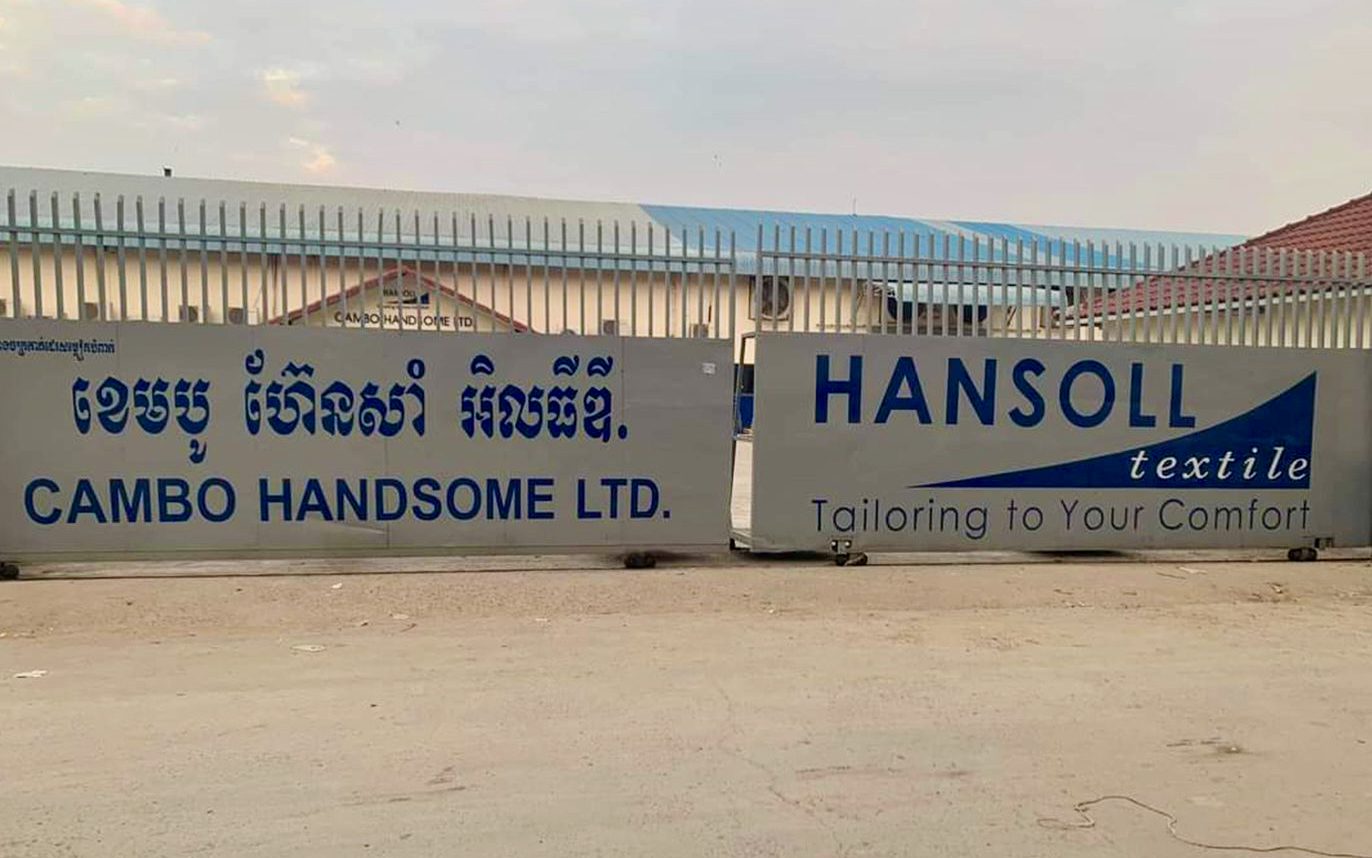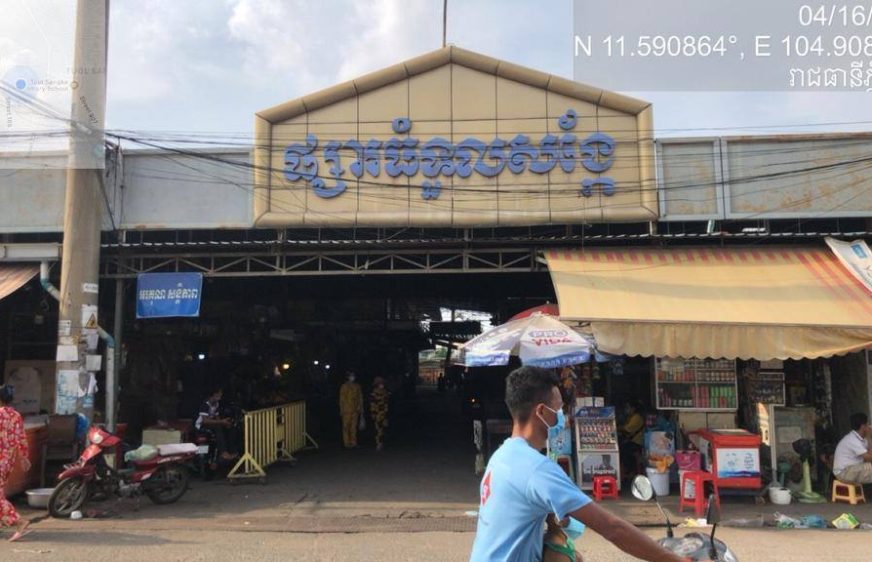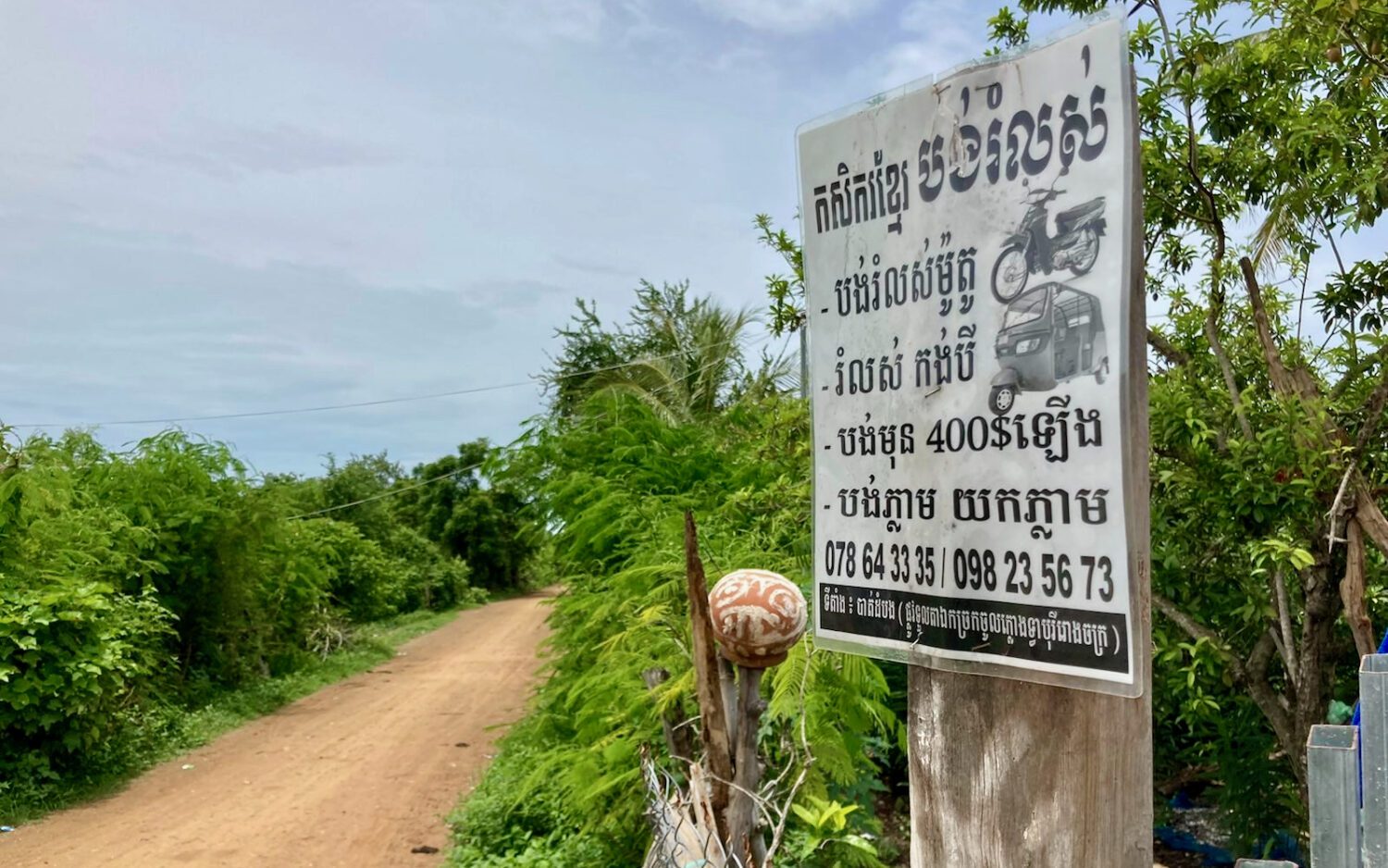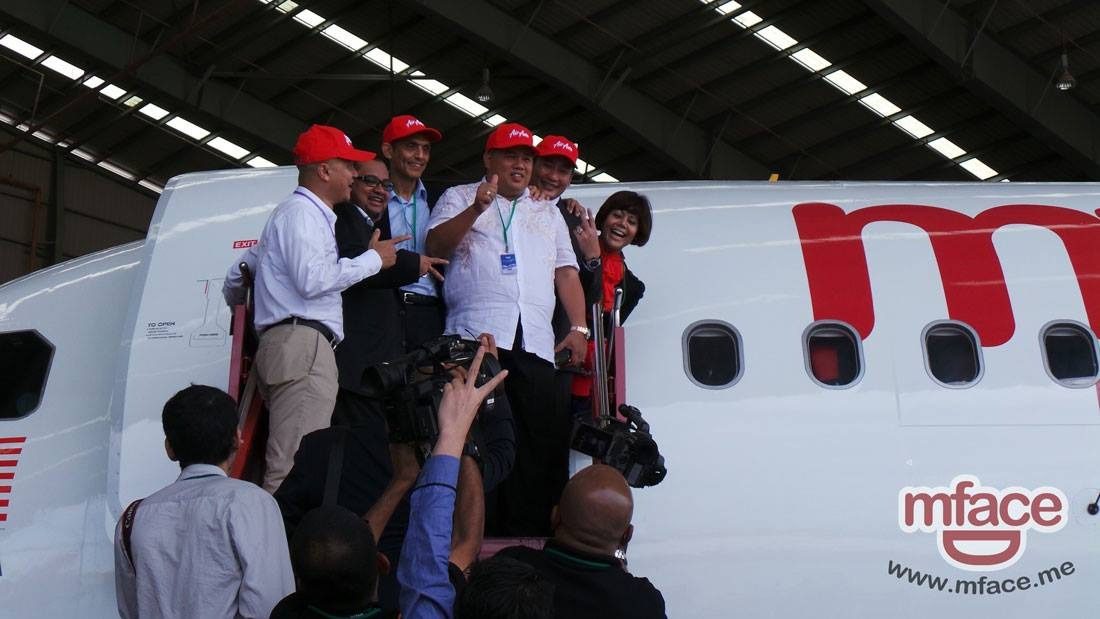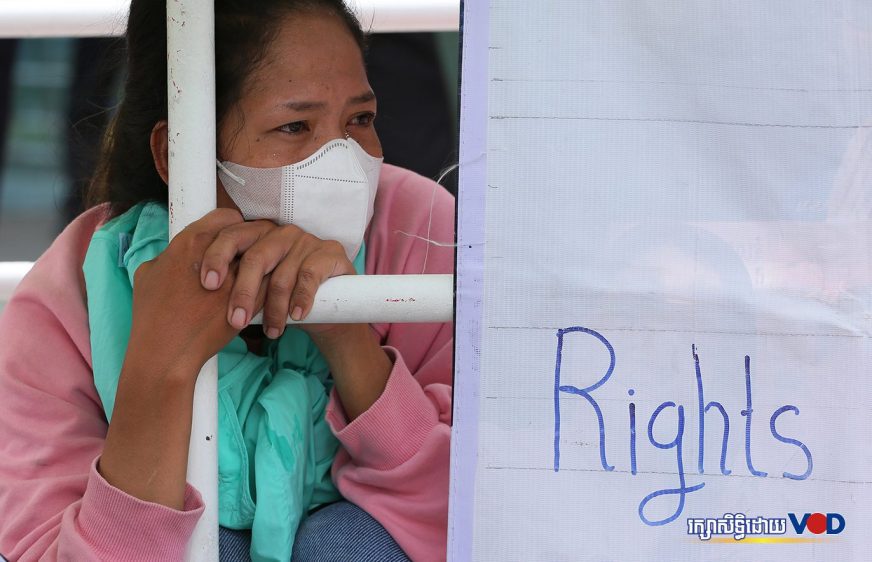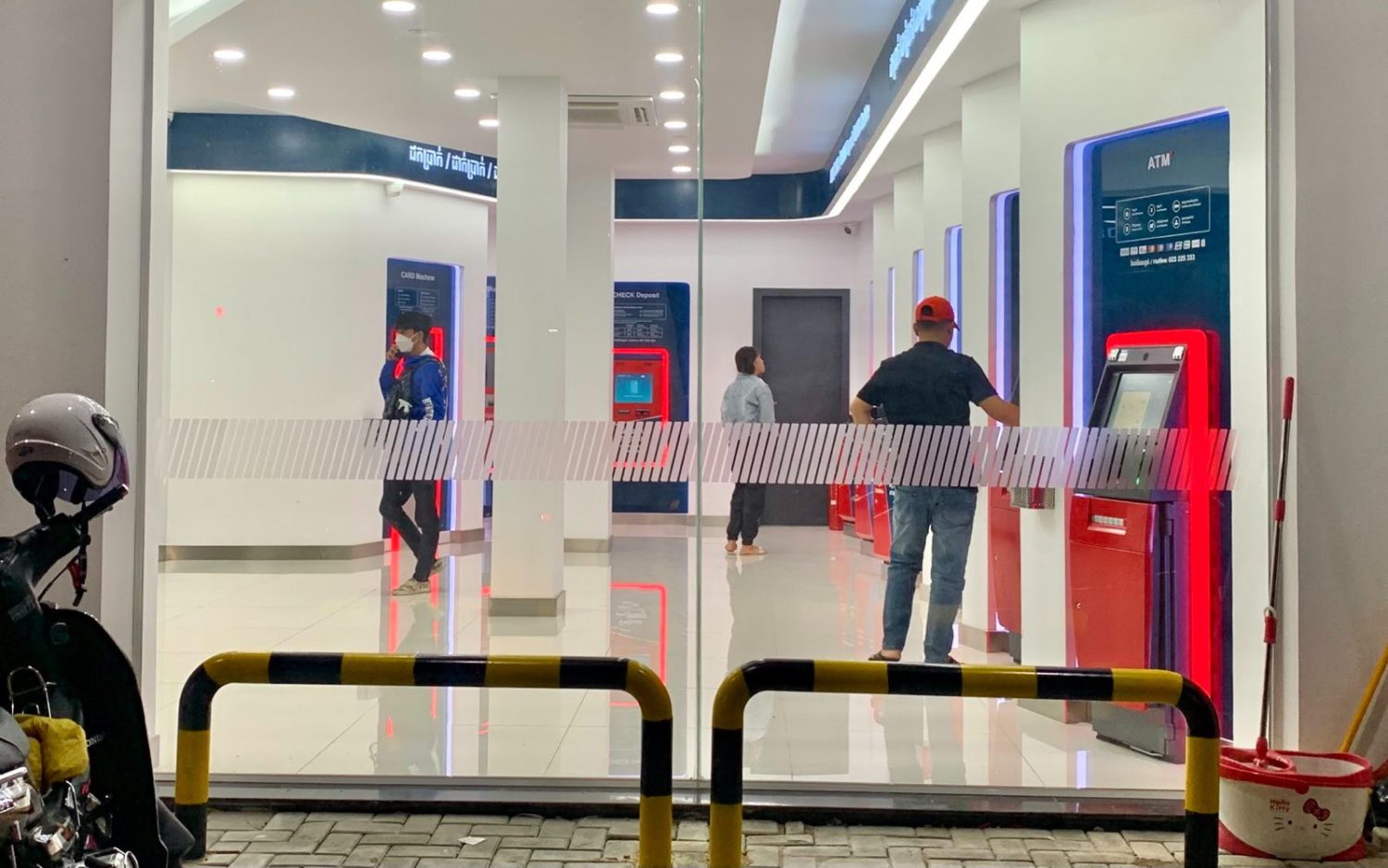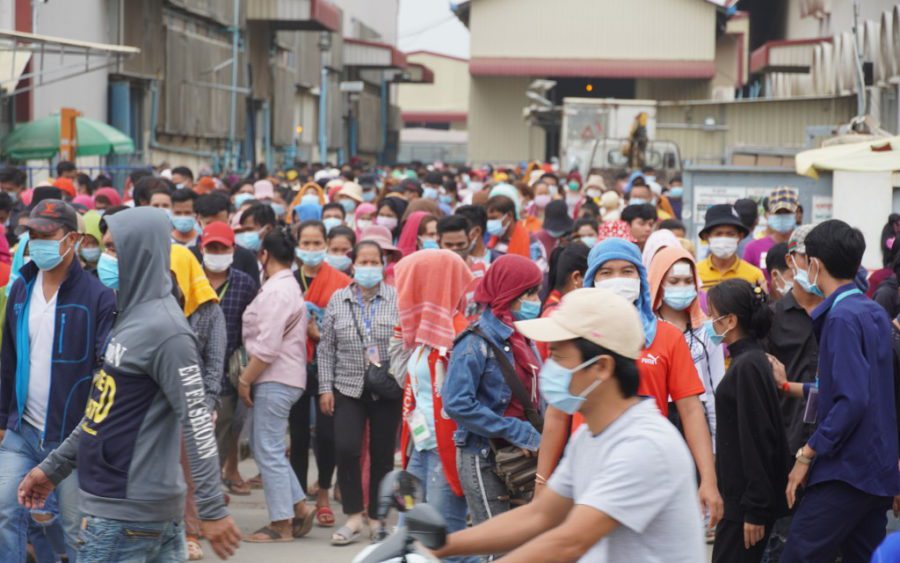High above the bar-patrons spilling into crowded streets in central Phnom Penh, Ma Srieng and his family settle in for a dinner of fish, rice and vegetables, unseen by the nightlife masses below.
Srieng, a 34-year-old construction worker from Kampong Chhnang Province, has finished work for the day. But he, his pregnant wife Som Theary, 29, and their 2-year-old son remain on the third floor of the building where Srieng works. The family have been living in the shell of the 18-storey condominium since December 2021, among around 50 workers living inside the building as it rises along the capital’s expatriate haven Bassac Lane.
“Living onsite, there’s no peace,” Srieng says. “It’s always noisy, there are always other workers coming and going, it’s not safe and there are disturbances, even when we’re tired and just want to relax.”
He’s one of an estimated 785,000 construction workers in Cambodia whose labour has transformed Phnom Penh’s skyline in recent years, with workers earning an average monthly wage of US$240. For many, their income is too little to afford housing off-site.
Srieng was previously a welder but in January he’s laying concrete following an eye injury. He has worked full-time in construction for five years, but he says this is his first experience living inside the building he’s working on. It’s a risky situation that has seen dozens of workers outside the capital crushed to death in recent years when unfinished buildings have collapsed due to unsafe and unregulated construction.
“I heard about the building collapses in Sihanoukville and Kep. I’ve heard of other places too,” Srieng says. “But we usually lived outside and so we didn’t worry the way we do [now while] living inside the building.”
Despite government pledges to ban workers from living inside half-built buildings following fatal collapses, many workers and their families continue to live inside the structures they are raising, including in central Phnom Penh. Few labour and social protections for these mostly informal workers leave them vulnerable to site accidents and labour exploitation.
“There are no jobs in our villages, so we all take out loans, then we come to work in construction as we are in debt, but in construction, there’s no contract—everything is just a verbal agreement,” says Sun Kim Yan, a worker at a smaller construction site in Phnom Penh’s Kambol District.
These economic conditions put most construction workers at the mercy of their employers, Kim Yan says. The poor treatment they face, he adds, is “because we’re cheap”.
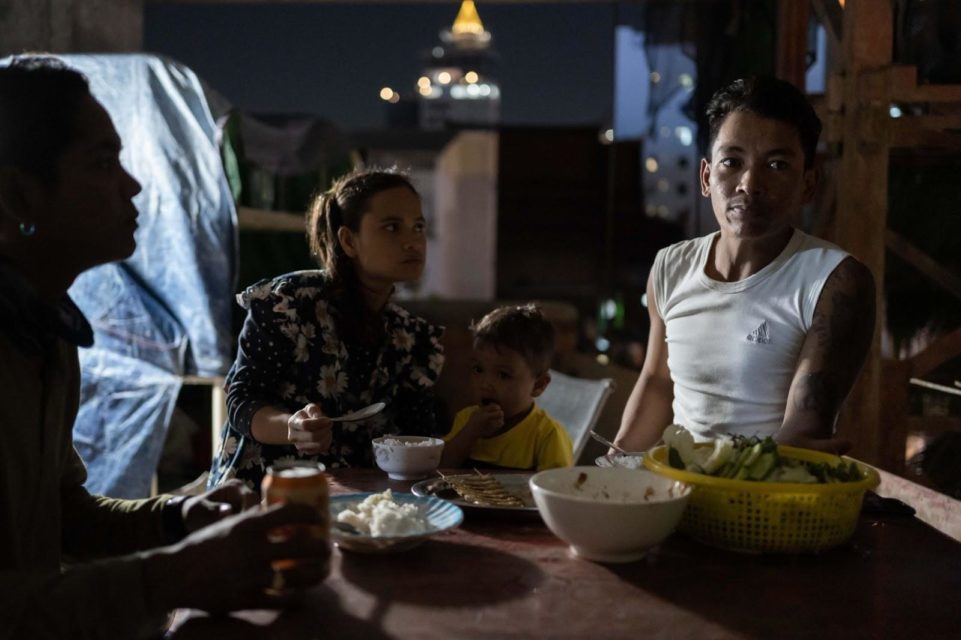
Underpaid and Unequipped
Sim Ry, the 29-year-old manager at Kim Yan’s site, says he has worked in construction since he was 15 years old. Accidents, injuries, not getting paid and not having enough food to eat are common experiences for workers, he says.
Phan Sochantra, one of Ry’s colleagues, agrees. Two months earlier, on the day Sochantra was supposed to be paid, a subcontractor ran off with the workers’ salaries and no one on-site was paid.
“Every construction worker experiences not being paid at least one time,” he says. At the end of 2021, after working two months without pay, he quit the job without ever receiving his wages.
Dieb Phearum, another worker at the Kambol District site and a cousin of Srieng, says he quit the Bassac Lane job after just 10 days because January came before he was paid for the work he did in December 2021. Short on cash, he pawned a gold ring his mother gave him for US$50 in order to buy food.
“I don’t want to work in construction again. It’s exhausting and I don’t want to live like this. I just want to go back to my village and raise livestock,” Phearum says, citing safety concerns like a lack of helmets, gloves and boots.
Ry, Phearum’s manager, recounts how he fell off the scaffolding of a building where he was working in Phnom Penh’s Toul Kork District in 2017.
“I fell because I was careless,” Ry says, explaining how he’d tried to carry a bucket of cement-mix materials while climbing the scaffolding without holding on and lost his balance.
Miraculously, he didn’t break any bones in the fall from the third floor, but recalls his whole body being covered in bruises.
“I didn’t have any PPE as I was contracted by the owner. If I’d been working for a large construction site, I would have had PPE,” Ry says, referring to standard safety equipment. Luckily, he says the building owner covered his hospital bills.
While larger, commercial construction sites are more likely to be registered and inspected by officials and stocked with appropriate protective equipment, according to Ry, smaller, informal sites often evade registration and operate on expired permits to cut corners, putting profits ahead of workers’ safety.
“Life in the construction industry is just survival,” he adds. “If we don’t work every day, we don’t make enough money.”
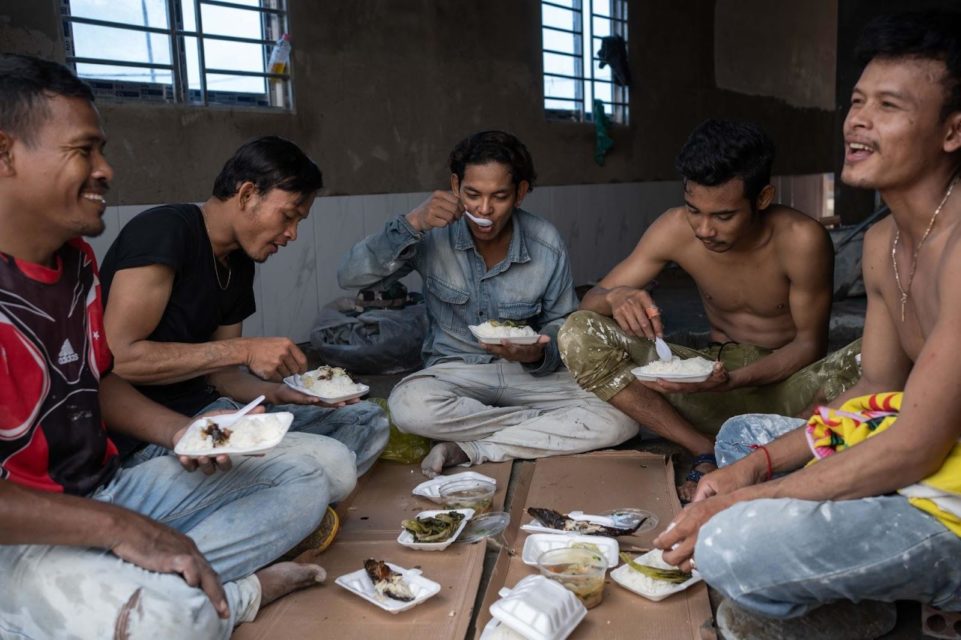
Children at Work
At the Bassac Lane site in December 2021, Srieng’s son wanders perilously close to an open gap in a wall that will one day be a window in a wealthier family’s condo. Four other families live on-site, with nine children in total, Srieng says.
“A few of them work on the site with us, even though they are underage. They have the energy for the job so they work,” he says.
But Srieng worries about his own child’s safety. “I worry that my son will fall while running around. The safety on-site isn’t good and his health has been affected. There’s a lot of dust.”
Reporters saw at least two youths shovelling gravel at the site, and Srieng says there are children as young as 10 working there. Other workers said in March that they were aware of three minors who were working.
A Chinese site manager, accompanied by a Cambodian translator, declined to speak with reporters multiple times and told them to leave the site.
The government has repeatedly denied instances of child labour in the brick-making industry which supplies the raw materials of the nation’s construction boom. A 2020 report from the US Department of Labor found that the rapid growth of the sector has fuelled child labour, notably at brick kilns, but also directly on construction sites.
Still, the report says labor inspectors were “rarely able to conduct inspections” of construction sites since owners affiliated with government officials obstructed inspectors from accessing their properties.
Cambodia’s Ministry of Labour conducted 111 inspections of construction sites in Phnom Penh in 2018 and two in 2016, according to a 2019 report from anti-poverty organisation CARE Cambodia. None were conducted in 2017, and limited information about the quality, type or outcomes of the inspections was provided by the ministry to CARE.
Spokespersons for the ministries of labour and land management could not be reached after multiple attempts. A person who answered a call to a phone number posted directly outside the site declined to comment.
According to Srieng, when labour inspectors do visit construction sites, they don’t speak with workers or actually inspect the site for safety violations. Instead, the inspectors meet with site managers or developer representatives and then leave, he says.
“They don’t inspect, they just take money,” Srieng claims. “If they weren’t taking money, there’s no way that our site would still be operational.”
During nine visits to the Bassac Lane site from December 2021 to March 2022, reporters repeatedly saw people working without standard safety equipment such as closed-toed footwear, helmets and harnesses.
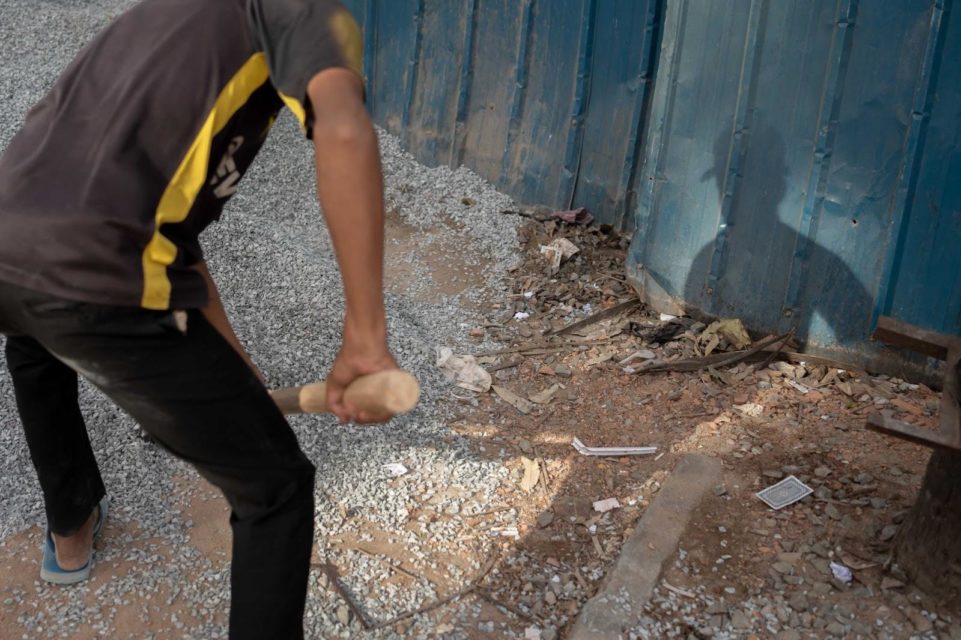
A Deadly Line of Work
With he, his wife and their youngest child living on-site, Srieng has good reason to be worried about safety risks. In June 2019, a seven-storey building in the coastal city of Sihanoukville collapsed in the early morning, killing 28 workers and injuring 26 more who had been sleeping in the unfinished building. Authorities later said the builders had not acquired the necessary permits, and four Chinese nationals linked to the collapse were sentenced to up to three years in prison for involuntary manslaughter and causing unintentional injury, damage and deaths.
Land Management Minister Chea Sophara said in July that year that the practice of construction workers living inside unfinished buildings was “not allowed”.
But about six months after the Sihanoukville collapse, another under-construction building came down, this time killing 36 people—including six children—and injuring an additional 23 in Kep Province. Officials said builders were adding a seventh storey when the structure fell. They had only been permitted to build six.
A week after the collapse in Kep, which was attributed to inadequate concrete pillars, officials issued a directive prohibiting people from living in unfinished buildings, even temporarily.In August 2020, a crane collapsed at a building site, falling on a neighbouring house and killing five people and injuring five others. The husband of one of the deceased told reporters the day after the crane collapsed that the housing developer’s representatives and officials had given him US$600 in total and 30 kilograms of rice.
The consecutive collapses occurred as Cambodia’s construction sector was booming. In 2018, the Land Management Ministry reported investments in the sector had reached US$5.2 billion. The following year, the ministry announced US$9.3 billion in sector investments, which dropped to US$7.7 billion in 2020 amid the COVID-19 pandemic. Real estate sector investments shot back up to US$10.3 billion in the first 11 months of 2021.
Despite the sector’s massive capital infusion in recent years, labour advocates say the government and employers invest little in worker safety and oversight.
After the 2019 building collapse in Sihanoukville, union leader Yann Thy recalls the government announcing that workers should not be allowed to sleep on-site.
“It was not a law, just an announcement, and what has the actual implementation been so far?” Thy says. “There are still workers sleeping on site. The problem is still a problem.”
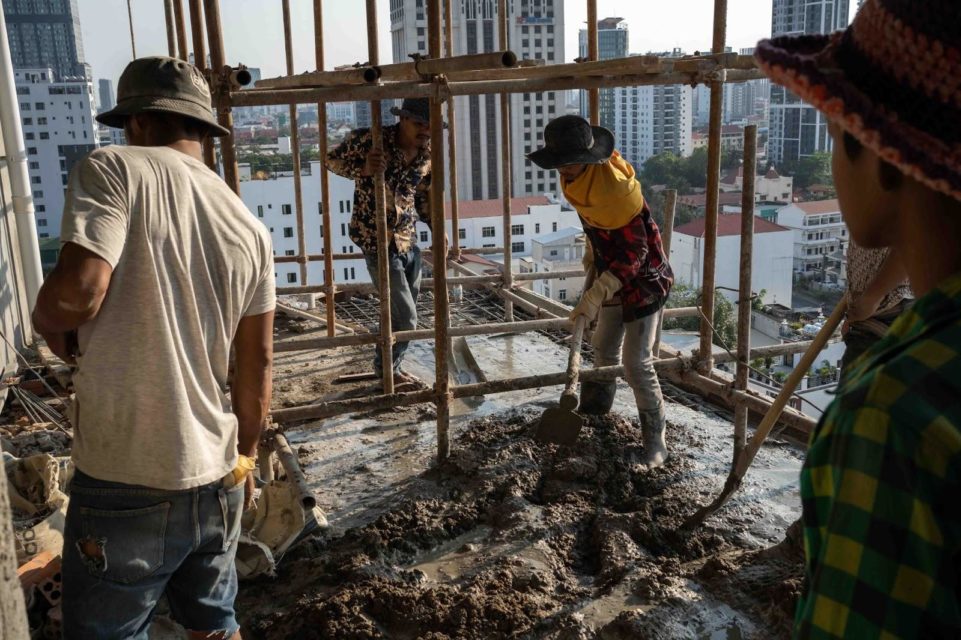
“Nothing Has Changed”
In 2017, the Building and Wood Workers Trade Union Federation of Cambodia (BWTUC) conducted a survey of 1,010 construction workers, the most recent union survey available, with 12% of those polled reporting feeling unsafe on construction sites. Nearly 1 in 5 said they had been injured while working, and 41% complained about a lack of safety equipment provided or used on-site. More than half of workers surveyed—62%—said they had never received occupational safety training.
According to the survey, 91% of construction workers could not access benefits from the National Social Security Fund, a government scheme that provides free or subsidised healthcare to some 2.6 million workers. In late 2020, the Labour Ministry announced that informal workers would also be able to register for NSSF benefits.
But to date BTWTUC has registered just about 60% of its approximately 10,000 members, since most construction workers, who are largely informal, transient labourers, lack the government-required fixed address to sign up, according to Yann Thy, the union’s secretary-general.
“Most construction workers still cannot access NSSF. Nothing has changed,” Thy says.
Heng Sophannarith, the NSSF’s deputy director-general, says that just a fraction of Cambodia’s total construction labour force—about 40,000 workers—were registered with NSSF as of March 2022.
NSSF documented 107 construction worker casualties in 2020, including five deaths and 34 serious injuries, according to Sophannarith. In 2021, 77 casualties were recorded, seven deaths and 34 serious injuries. But the figures, the official explains, only include data reported by the approximately 10% of construction companies registered with NSSF.
In addition to limited access to government-funded healthcare, Thy from BTWTUC says the rise of subcontracting, the seasonal shift from construction to agricultural work and the general informal nature of the construction sector make unionising workers a challenge.
“Sometimes they work for a few months then move to another construction site because the wage is less or it’s difficult to get paid,” he says. “The [workers’] voice is divided.”
Few organised construction workers makes it tough for BWTUC to hold much sway with the government, and years of campaigning for new laws requiring higher safety standards and a minimum wage in the construction sector, similar to the larger garment sector, have seen little progress. In 2018, Prime Minister Hun Sen pledged to establish a minimum wage for construction workers, but nothing has materialised.
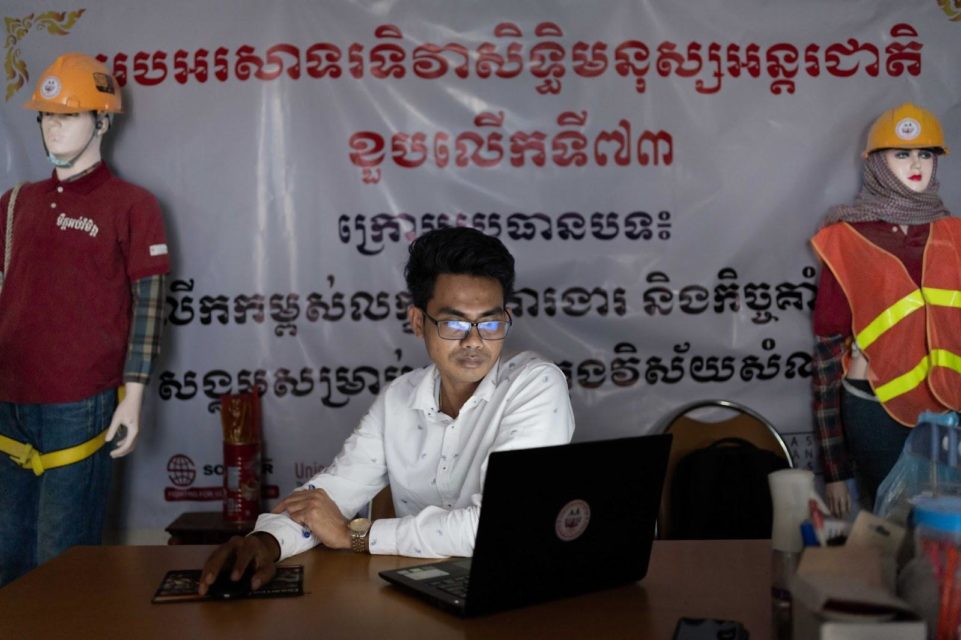
Raising a Family On-Site
At the Bassac Lane site, Srieng’s wife Theary, who is six-months pregnant, struggles to get around the unfinished condo building, although she makes do.
“It’s so hard to get up and down, to get out to the market, but I can handle it. I’m used to living like this,” Theary says. “We’ve lived on building sites since we were married.”
But she complains of having to use an access elevator meant to move building materials just to reach the outdoor bathroom, which is on the ground floor and offers little privacy. In addition, the drinking, card-playing and late nights of the mostly male construction workers grate on her.
“I’m so bored of listening to it, but I can’t stop them from drinking. It’s not like having your own home where you want peace. Here on-site, they just want to drink,” she says.
All the women on-site watch out for any children playing close to the edges of the second, third and fourth floors where workers live.
Srieng says he is determined to ensure that his next child does not grow up on a construction site. His wages have risen from US$6.15 per day five years ago to US$15 per day, more than less experienced workers can expect in Phnom Penh, but as he notes: “Babies aren’t cheap.”
He also sends US$25 a month to his parents in Kampong Chhnang Province to cover school fees for his and his first wife’s 7-year-old daughter who lives with her grandparents.
When the new baby comes, Srieng says he will struggle to meet his family’s basic needs. He wants to get out of construction and start a fish farm, but he needs to save money first.
“I’ll find work, anything besides stealing and robbing,” he says.
As of late February, Srieng quit his job at the Bassac Lane site and moved to Sihanoukville for one last job before his next child is due. Theary and their 2-year-old son went with him, but the family intends to move back to Kampong Chhnang for the new baby’s birth.
Until then, Srieng and his family continue to face the same risks of living on-site as many of Cambodia’s construction workers. But his main concern remains providing for his wife and children.
“If I die while working, all I want is for my family to be supported financially.”
See also: Photo Essay: Behind the Scaffolding. The photo essay was updated on April 7 with a range of estimates about the number of construction workers in the country. A photo caption was also corrected as it was not confirmed whether the depicted worker was underage.
This article is a collaboration between VOD and New Naratif.
 This article is produced with the financial support from Rosa-Luxemburg-Stiftung in Southeast Asia via its Hanoi office.
This article is produced with the financial support from Rosa-Luxemburg-Stiftung in Southeast Asia via its Hanoi office.



